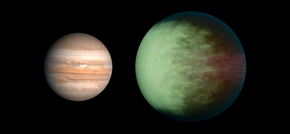 Size comparison of Kepler-7b with Jupiter, showing a rudimentary map of its atmosphere[1] derived from telescope observations | |
| Discovery[2] | |
|---|---|
| Discovery date | January 4, 2010[3] |
| Transit (Kepler Mission)[2] | |
| Orbital characteristics | |
| 0.06224 AU | |
| Eccentricity | 0[2] |
| 4.885525±0.000040[2] d | |
| Inclination | 86.5[4] |
| Star | Kepler-7 |
| Physical characteristics | |
| 1.478+0.050 −0.051[2] RJ | |
| Mass | 0.433+0.040 −0.041[2] MJ |
Mean density | 0.166+0.019 −0.020 g/cm3[citation needed] |
| Albedo | 0.32±0.03[5][6] |
| Temperature | 1,540 K (1,270 °C; 2,310 °F)[2] |
Kepler-7b is one of the first five exoplanets to be confirmed by NASA's Kepler spacecraft, and was confirmed during the first 34 days of Kepler's science operations.[2] It orbits a star slightly hotter and significantly larger than the Sun that is expected to soon reach the end of the main sequence.[2] Kepler-7b is a hot Jupiter that is about half the mass of Jupiter, but is nearly 1.5 times its size; at the time of its discovery, Kepler-7b was the second most diffuse planet known, surpassed only by WASP-17b.[2] It orbits its host star every five days at a distance of approximately 0.06 AU (9,000,000 km; 5,600,000 mi). Kepler-7b was announced at a meeting of the American Astronomical Society on January 4, 2010. It is the first extrasolar planet to have a crude map of cloud coverage.[7][8][9]
- ^ Cite error: The named reference
cloudUCSCwas invoked but never defined (see the help page). - ^ a b c d e f g h i j Cite error: The named reference
Latham2010was invoked but never defined (see the help page). - ^ Cite error: The named reference
sciencenewswas invoked but never defined (see the help page). - ^ Cite error: The named reference
datatablewas invoked but never defined (see the help page). - ^ Angerhausen, Daniel; DeLarme, Em; Morse, Jon A. (2015). "A Comprehensive Study of Kepler Phase Curves and Secondary Eclipses: Temperatures and Albedos of Confirmed Kepler Giant Planets". Publications of the Astronomical Society of the Pacific. 127 (957): 1113–1130. arXiv:1404.4348. Bibcode:2015PASP..127.1113A. doi:10.1086/683797. S2CID 118462488.
- ^ Heng, Kevin; Demory, Brice-Oliver (2013). "Understanding Trends Associated With Clouds In Irradiated Exoplanets". The Astrophysical Journal. 777 (2): 100. arXiv:1309.5956. Bibcode:2013ApJ...777..100H. doi:10.1088/0004-637X/777/2/100. S2CID 119298230.
- And errata in Heng, Kevin; Demory, Brice-Olivier (2014). "ERRATUM: "UNDERSTANDING TRENDS ASSOCIATED WITH CLOUDS IN IRRADIATED EXOPLANETS" (2013, ApJ, 777, 100)". The Astrophysical Journal. 785: 80. doi:10.1088/0004-637X/785/1/80.
- ^ Clavin, Whitney; Johnson, Michele; Cole, Steve (30 September 2013). "NASA Space Telescopes Find Patchy Clouds on Exotic World". NASA. Archived from the original on 17 October 2013. Retrieved 30 September 2013.
- ^ Chu, Jennifer (2 October 2013). "Scientists generate first map of clouds on an exoplanet". MIT. Retrieved 2 January 2014.
- ^ Demory, Brice-Olivier; et al. (2013). "Inference of Inhomogeneous Clouds in an Exoplanet Atmosphere". The Astrophysical Journal Letters. 776 (2): L25. arXiv:1309.7894. Bibcode:2013ApJ...776L..25D. doi:10.1088/2041-8205/776/2/L25. S2CID 701011.